USA 1989
"Prehistorical animals"
| Issue Date |
01.10.1989 |
| ID |
Michel:
2051-2054 Scott:
2422-2425 Stanley Gibbons: 2407-2410
Yvert: 1873-1876 UPU: N/A
Category: pR |
| Author |
John
Gurche |
| Stamps in set |
4 |
| Value |
c25 - Tyrannosaurus
c25 - Stegosaurus
c25 - Brontosaurus (Apatosaurus)
c25 - Pteranodon Cartoon
'Stamposaurus' in sheet margin. |
| Size (width x height) |
|
| Layout |
20
stamps per sheet |
| Products
|
FDC x |
| Paper |
|
| Perforation |
11.1x11.1 |
| Print
Technique |
Lithographed and engraved, multicolor
|
| Printed
by |
Bureau of Engraving and Printing |
| Quantity |
101,747,000 |
| Issuing Authority |
U.S. Postal Service |
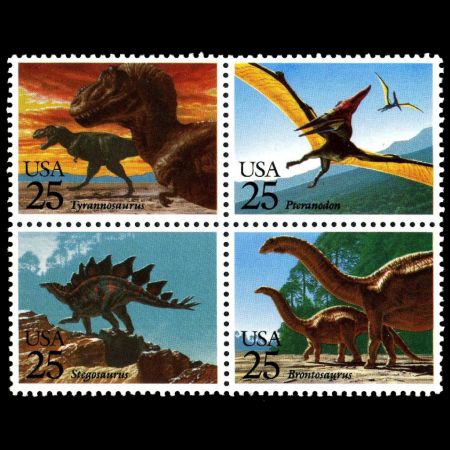
A pre-historic dimension was added to stamp collecting when the Postal
Service issued a block of four Dinosaur stamps.
They were issued on October 1
st, to coincide with the beginning of National Stamp
Collecting Month.
The vividly colored stamps feature four of the more well-known dinosaurs.
The predatory tyrannosaurus rex is frozen in the act of hunting out his daily meal.
Unlike today's
paleo dieter
who can simply learn
how to make meatloaf
or purchase a good steak, the carnivorous dinosaurs had to hunt and kill their own prey.
The winged pteranodon soars high overhead.
The stegosaurus is ambling up a landscape as rough and uneven as his armor-plating.
The gentle vegetarian brontosaurus, meaning thunder lizard, was named for its gigantic size.
The
origin of dinosaurs is uncertain. During their 140-million-year reign,
however, many new varieties evolved and older types died out. Not all
kinds of dinosaurs became extinct at once. The last of the dinosaurs
disappeared at the end of the Cretaceous period. Many other types of
animals died out at the same time, including icththyosaurs, mosasaurs,
plesiosaurs, flying reptiles, and a variety of lower organisms. The
cause of the widespread extinction is unknown, although attributed to a
variety of situations.
For
the U.S. Postal Service, this issue served as a promotional tie-in with
the videocassette release of the movie, "The Land Before
Time".
|
Stegosaurus
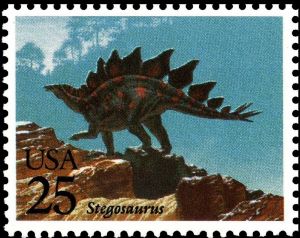 Stegosaurus
is one of the plated dinosaurs, which grew to about 20 feet (6 m) long,
eight-feet (2.5 m) high at the hips, and about four tons in weight. It
had a blimp-like body, long hind legs, short front legs, a short and
stocky neck, and a small head. Its long, heavy tail carried pairs of
long, bony spikes, thought to be used as defensive weapons against
predators. The origin of dinosaurs is uncertain. During their
140-million-year reign, however, many new varieties evolved and older
types died out. Not all kinds of dinosaurs became extinct at once. The
last of the dinosaurs disappeared at the end of the Cretaceous period.
Many other types of animals died out at the same time, including
icththyosaurs, mosasaurs, plesiosaurs, flying reptiles, and a variety
of lower organisms. The cause of the widespread extinction is unknown,
although attributed to a variety of situations. Stegosaurus
is one of the plated dinosaurs, which grew to about 20 feet (6 m) long,
eight-feet (2.5 m) high at the hips, and about four tons in weight. It
had a blimp-like body, long hind legs, short front legs, a short and
stocky neck, and a small head. Its long, heavy tail carried pairs of
long, bony spikes, thought to be used as defensive weapons against
predators. The origin of dinosaurs is uncertain. During their
140-million-year reign, however, many new varieties evolved and older
types died out. Not all kinds of dinosaurs became extinct at once. The
last of the dinosaurs disappeared at the end of the Cretaceous period.
Many other types of animals died out at the same time, including
icththyosaurs, mosasaurs, plesiosaurs, flying reptiles, and a variety
of lower organisms. The cause of the widespread extinction is unknown,
although attributed to a variety of situations. |
Brontosaurus
(Apatosaurus)
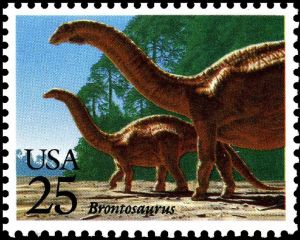 The
inscription on the stamp incorrectly identifies this beast as a
brontosaurus. Apatosaurus is one of the giant, plant-eating dinosaurs
that roamed western United States during the late Jurrasic period.
These five-toed, long-necked dinosaurs were the dominant herbivores of
their time. The origin of dinosaurs is uncertain. During their
140-million-year reign, however, many new varieties evolved and older
types died out. Not all kinds of dinosaurs became extinct at once. The
last of the dinosaurs disappeared at the end of the Cretaceous period.
Many other types of animals died out at the same time, including
icththyosaurs, mosasaurs, plesiosaurs, flying reptiles, and a variety
of lower organisms. Cause of the widespread extinction is unknown,
although attributed to a variety of situations. The
inscription on the stamp incorrectly identifies this beast as a
brontosaurus. Apatosaurus is one of the giant, plant-eating dinosaurs
that roamed western United States during the late Jurrasic period.
These five-toed, long-necked dinosaurs were the dominant herbivores of
their time. The origin of dinosaurs is uncertain. During their
140-million-year reign, however, many new varieties evolved and older
types died out. Not all kinds of dinosaurs became extinct at once. The
last of the dinosaurs disappeared at the end of the Cretaceous period.
Many other types of animals died out at the same time, including
icththyosaurs, mosasaurs, plesiosaurs, flying reptiles, and a variety
of lower organisms. Cause of the widespread extinction is unknown,
although attributed to a variety of situations. |
|
Tyrannosaurus
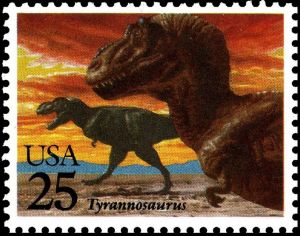 Tyrannosaurus,
the best-known of all dinosaurs, was the largest and last of the
meat-eating carnosaurs. It walked on its hind legs and stood about 18
feet (5.5 m) high. Its total length was about 50 feet (15 m), and it
weighed more than eight tons. The origin of dinosaurs is uncertain.
During their 140-million-year reign, however, many new varieties
evolved and older types died out. Not all kinds of dinosaurs became
extinct at once. The last of the dinosaurs disappeared at the end of
the Cretaceous period. Many other types of animals died out at the same
time, including icththyosaurs, mosasaurs, plesiosaurs, flying reptiles,
and a variety of lower organisms. The cause of the widespread
extinction is unknown, although attributed to a variety of situations. Tyrannosaurus,
the best-known of all dinosaurs, was the largest and last of the
meat-eating carnosaurs. It walked on its hind legs and stood about 18
feet (5.5 m) high. Its total length was about 50 feet (15 m), and it
weighed more than eight tons. The origin of dinosaurs is uncertain.
During their 140-million-year reign, however, many new varieties
evolved and older types died out. Not all kinds of dinosaurs became
extinct at once. The last of the dinosaurs disappeared at the end of
the Cretaceous period. Many other types of animals died out at the same
time, including icththyosaurs, mosasaurs, plesiosaurs, flying reptiles,
and a variety of lower organisms. The cause of the widespread
extinction is unknown, although attributed to a variety of situations.
|
Pteranodon
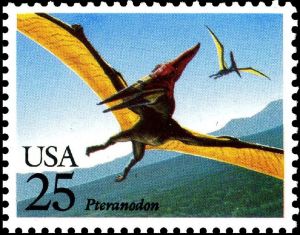 .Pteranodon
is a genus of pterosaurs which included some of the largest known
flying reptiles, with wingspans over 6 metres (20 ft). It existed
during the late Cretaceous geological period of North America in
present day Kansas, Alabama, Nebraska, Wyoming, and South Dakota. More
fossil specimens of Pteranodon have been found than any other
pterosaur, with about 1,200 specimens known to science, many of them
well preserved with nearly complete skulls and articulated skeletons.
It was an important part of the animal community in the Western
Interior Seaway. .Pteranodon
is a genus of pterosaurs which included some of the largest known
flying reptiles, with wingspans over 6 metres (20 ft). It existed
during the late Cretaceous geological period of North America in
present day Kansas, Alabama, Nebraska, Wyoming, and South Dakota. More
fossil specimens of Pteranodon have been found than any other
pterosaur, with about 1,200 specimens known to science, many of them
well preserved with nearly complete skulls and articulated skeletons.
It was an important part of the animal community in the Western
Interior Seaway.
Pteranodon
was a reptile, but not a dinosaur. By definition, all dinosaurs belong
to the groups Saurischia and Ornithischia, which exclude pterosaurs.
Nevertheless, Pteranodon is frequently featured in dinosaur books and
is strongly associated with dinosaurs by the general public.
|
Products
| FDC |
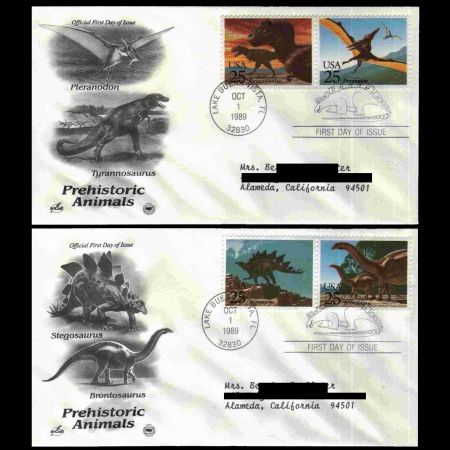 |
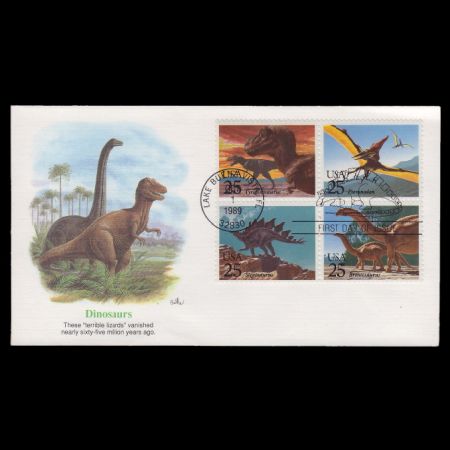 |
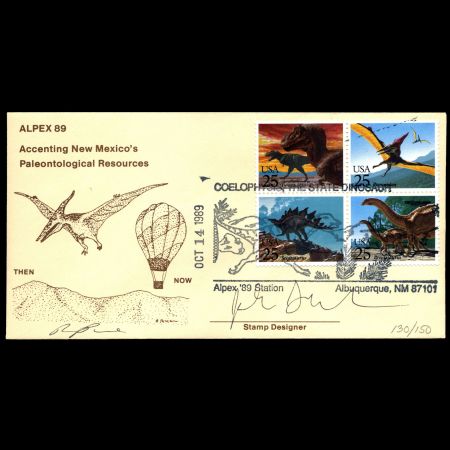 |
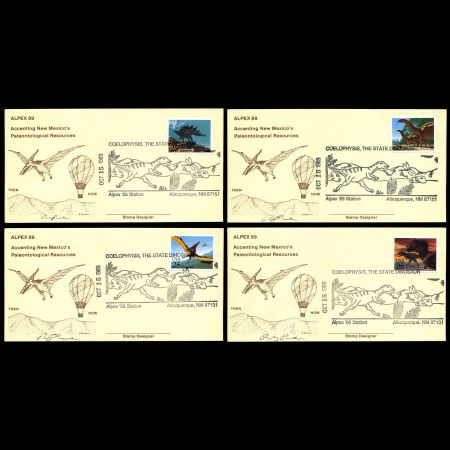 |
|
Stamps Sheet
|
Souvenir page
|
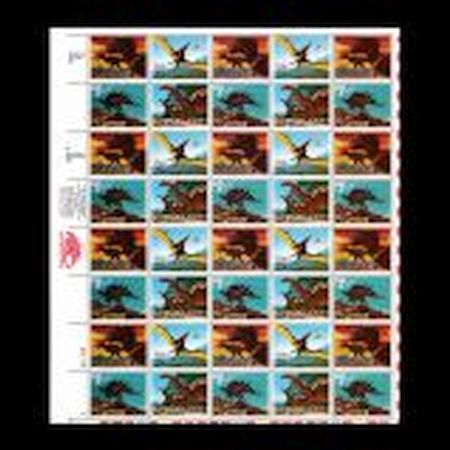 |
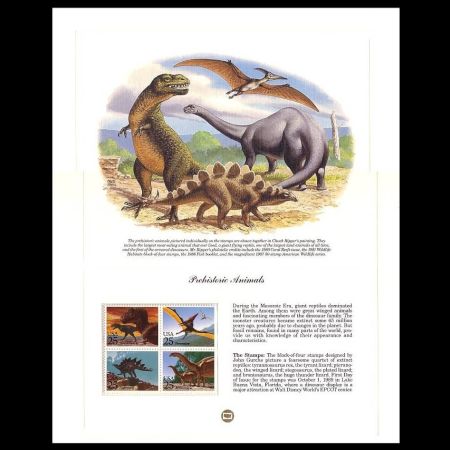 |
| USED covers |
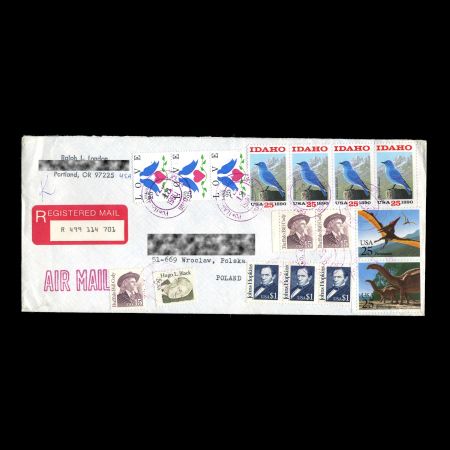 |
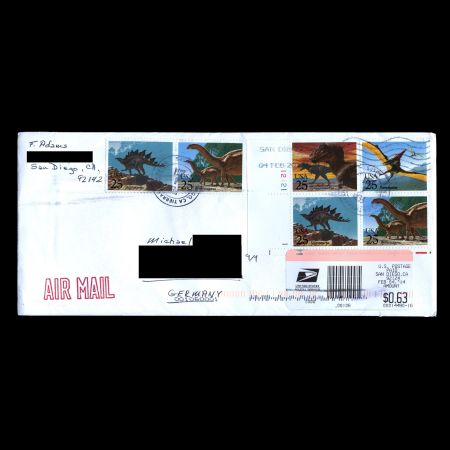 |
References:
stampedout
mysticstamp
Wikipedia
Last update 14.01.2018
Any feedback, comments or even complaints
are welcome: [email protected] (you
can email me on ENglish, DEutsch, or RUssian)













